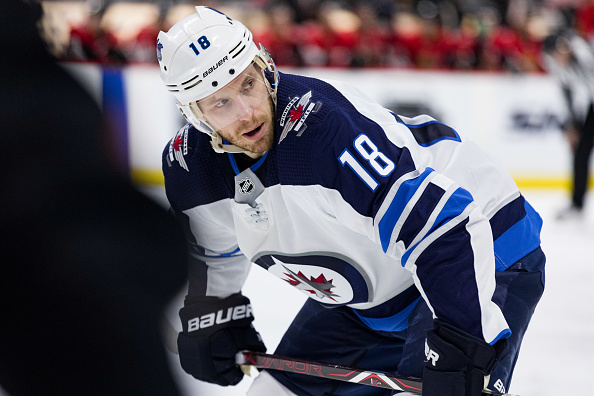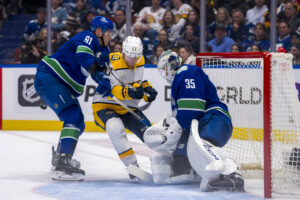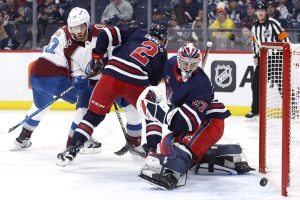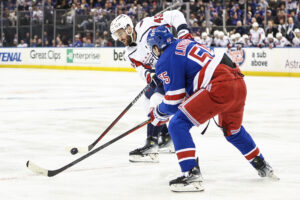Player development seems to always result in more questions than answers. How likely is it for a top pick to pan out? What makes a player a “steal”? Last Word On Hockey will be starting a new series on how to properly develop prospects from all different spots throughout the draft. This week’s piece involves top-15 picks and how they were used early in their careers.
Player Development Of Top-15 Picks
In the span of 2005 through 2015, there were 21 total selections made between 11th overall and 15th overall on forwards playing in North America. Looking at all 21 forwards, they were split into different categories. Today, we’ll look at the category of “Brought in immediately when deemed NHL-ready.” That category had three players. Those players were Bryan Little, Max Domi, and Peter Holland. In this piece, we will look at Little and Domi.
Player Development Of Bryan Little
Little, drafted 12th overall by the Atlanta Thrashers in the 2006 NHL entry draft, is still getting paid over $5 million per season to this day. Coming out of the Barrie Colts organization in the OHL, Little produced 36 goals and 32 assists for 68 points in 62 games in his DY-1 season. That resulted in a rate of 1.097 points per game, ranking third among those 21 forwards. The following season, Little would record 42 goals and 67 assists for 109 points in 64 games in his DY season. That was good for 1.703 points per game, ranking first among those same 21 forwards in DY production.
Despite being among the best of all the players in the 11 through 15 range in the draft, the precedent set by top-10 picks deemed him “close” to NHL-ready. Thus, Atlanta gave him another full season of juniors. In his DY+1 season, Little would record 41 goals and 66 assists for 107 points in 57 games. That was good for 1.877 points per game, ranking second among the 20 forwards still not playing at the NHL level in DY+1 production.
How Was Little Used?
In his first professional season, Little would see a split between the NHL and AHL. In 34 AHL games, Little scored nine goals and 16 assists for 25 points. At the NHL level, Little would score six goals and 10 assists for 16 points in 48 games, where he averaged 15:37 time on ice per game. In that role, Little would post modest advanced stats. His even-strength offence goals above replacement (EVO) was 0.5, while his even-strength defence goals above replacement (EVD) was at 1.0. Decent for a young kid in a small role. With that fairly solid even-strength play, Little would also record 0.1 wins above replacement (WAR) and 0.5 goals above replacement (GAR). Again, nothing crazy, but solid for a rookie.
In his second season, he became a mainstay on the Thrashers roster. Across 79 games, Little would average 16:55 time on ice per game, a raise from the year before. In that role, Little would score 31 goals and 20 assists for 51 points. His analytics went up to outstanding numbers, with his EVO (8.8) being a massive raise from the year before. While his EVD (1.3) stayed similar, it was still really good for a young kid. With the drastic improvement to his offensive game at five on five, Little’s WAR (3.0) and GAR (16.7) rose to elite scores.
Little’s Player Development Takes Step Back
In his third season, Little would again see 79 NHL games, this time averaging 15:45 time on ice per game. A step back in ice time despite incredible numbers, he only recorded 13 goals and 21 assists for 34 points. His counting stats took a big step back, as did his analytics. While his EVO (2.8) was still okay, it was still poor compared to his second season, and his EVD (-0.1) dipped below replacement level for the first time. With this dip analytically at five on five, Little would see his WAR (0.8) and GAR (4.7) drop considerably. Little’s player development through these seasons wasn’t great. Putting up elite stats in year two, he deserved more ice time in year three. Instead, he saw a reduced ice time.
Since the end of that third season, he remained with the Thrashers organization, even though they relocated to Winnipeg, becoming the Winnipeg Jets. Across those next 10 seasons, Little played 637 games, scoring 167 goals and 253 assists for 420 points. The last season Little played was 2019-20, in which he played just seven games (with five points). Little sustained a concussion in the preseason of the 2019-20 year, was cleared to play, then got injured in the seventh game after being struck by a puck in the head. He had surgery to repair a perforated eardrum, and he hasn’t played since. It’s unlikely Little will return to the NHL.
Player Development Of Max Domi
Domi, drafted with the 12th overall pick in the 2013 NHL draft by the then-Phoenix Coyotes, is the son of former NHLer, Tie Domi. Coming out of the OHL with the London Knights, Domi posted 21 goals and 28 assists for 49 points in 62 games in his DY-1 season. That was good for a points per game pace of 0.79. That rate ranked eighth out of the 21 forwards in DY-1 production. He followed that season up with 39 goals and 48 assists for 87 points in 64 games played. That was good for 1.359 points per game, ranking fifth out of those same 21 forwards in DY production.
After getting drafted by the Coyotes, Domi would remain in the OHL for another two seasons. In his DY+1 season, Domi would record 34 goals and 59 assists for 93 points in 61 games, good for 1.525 points per game. That rate ranked fourth among the 20 forwards still playing outside the NHL in DY+1 production. The following season, Domi would become the captain of the Knights. With the “C” on his jersey, Domi would score 32 goals and 70 assists for 102 points in just 57 games. That’s good for 1.789 points per game, ranking first among 12 players outside the NHL in DY+2 production.
How Was Domi Used?
In his first professional season, Domi would play 81 NHL games. He averaged 16:22 time on ice per game and scored 18 goals and 34 assists for 52 points. That production got him in the top-10 for Calder voting, finishing sixth according to Hockey-Reference. Domi would produce impressive underlying stats, at least offensively. His EVO was up at 7.5, and that led to his WAR (2.4) and GAR (12.3) to be extremely impressive for a first-year player. However, his EVD (-2.3) was a fair amount below replacement level.
In his second season, Domi would play just 59 NHL games, scoring nine goals and 29 assists for 38 points. He did this while averaging 16:59 time on ice per game. His EVO (7.3) would remain very similar to his rookie year, but his EVD (-3.3) by quite a bit. His WAR (1.1) and GAR (5.8) would drop quite a lot because of this step-back in terms of defensive impact.
Offence Improves, Defence Declines Further
In his third NHL season, Domi would play his first full 82-game season, recording nine goals and 36 assists for 45 points while averaging 16:42 time on ice per game. His advanced stats continued the same trend, with his EVO (9.6) remaining at a high level, and even improving considerably. Meanwhile, his EVD (-4.9) would drop yet again, causing his WAR (0.7) and GAR (3.5) to continue to drop. That’s despite some impressive underlying offensive stats. Hard to blame the Montreal Canadiens for not furthering his player development with a larger role when he can’t be reliable defensively.
Following those three seasons, he would leave Arizona via trade and join the Canadiens, where he would play for two seasons. In 153 games as a Hab, Domi would record 45 goals and 71 assists for 116 points while averaging 17:15 time on ice per game. He would get dealt to the Columbus Blue Jackets after those two seasons, where he would play one COVID shortened season and a half of the following season. In total, Domi would play 107 games with Columbus, scoring 18 goals and 38 assists for 56 points, averaging 14:19 time on ice per game. As mentioned, he played a half of a season with Columbus, due to being dealt yet again, this time to the Carolina Hurricanes. He scored two goals and five assists for seven points in 19 games. That’s while averaging just 11:59 time on ice per game.
Junior league stats via Elite Prospects, NHL stats via Hockey Reference, NHL analytics via Evolving Hockey
Main Photo:






